#Kokanee
Explore tagged Tumblr posts
Text
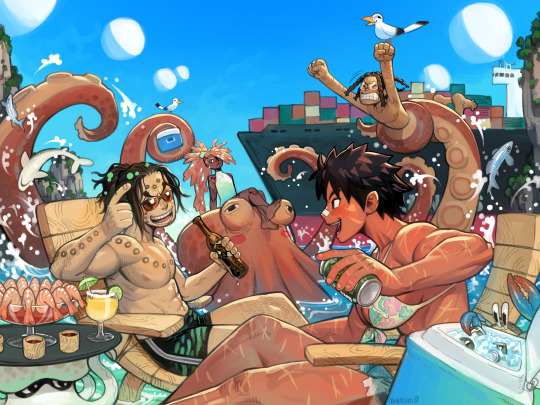
Beach Fun
77 notes
·
View notes
Text

Kokanee (salmon) in Kokanee (creek)
2 notes
·
View notes
Video
youtube
Halloween Treats for Adults - Stock Up For Your Halloween Party at Shoot...
Adult Treats This Halloween - Shooters Liquor Store South Surrey #Surrey #SurreyBC #Beer #Wine #ColdBeer #Spirits #Rum #Whiskey #Vodka #Tequila #Drinks #alcohol #ColdBeer #Beverages #Party #Halloween #Adults #Mix #Specialty #Liquor #Liquors #Baileys #Budweiser #Molson #Labatt #Whiskeylovers #IrishCream #CraftBeers #Local #Wine #sparklingwine #partysupplies #Shooters #CampbellHeights #SouthSurrey #LangleyBC #Convenience #greatprices #Liquorstore #BeerStore #WineStore #ShootersLiquorStore #Fireball
#youtube#Shooters Liquor Store#Shooters#Fireball#Kokanee#Coors#Budweiser#Vodka#Whiskey#South Surrey#Surrey BC#Langley BC#Brookswood#Campbell Heights#Liquor Store#Beer Store#192 Street#wine#Drinks
0 notes
Text

you have to keep going no matter what
282 notes
·
View notes
Text
Fish of the Day
Today's fish of the day is a bit different from normal, instead of focusing on a particular species of genus we will be focusing on landlocked salmon today by special request of Topi!

(Atlantic Salmon)
Landlocked salmon are notable due to the inherent nature of the salmon life cycle, where salmon hatch in a freshwater stream, migrate to the ocean until they achieve sexual maturity, and then travel back to the same stream they hatched from. However, landlocked salmon are unable to migrate and spend their life cycles entirely in freshwater. The three main landlocked salmon would be The Kokanee salmon (Oncorhynchus nerka), which are a subspecies of sockeye salmon, the Formosan landlocked salmon (Oncorhynchus masou formosanus), which is a subspecies of masu salmon, and finally the several populations of landlocked Atlantic salmon (Salmo salar).

(Formosan landlocked salmon)
Landlocked salmon hold almost no differences to their sea run relatives, other than that which speciation provides. Almost always landlocked salmon are far smaller. Considering that salmon are mid level carnivores, whose diet shifts based on age, freshwater prey is just simply less available than marine prey is. Salmon fry survive off of zooplankton, which is available in large amounts in freshwater, but as they grow into juveniles who eat worms and larvae, but by the time they are of age to transition to the marine environment, they rely on larger prey, such as other fish or squid. This is why landlocked salmon are far smaller, and often considered a far blander flavor by fishers.

(Atlantic salmon)
Another difference between the anadromous (migratory) fish and the non migratory is based on the migration pathways themselves. Landlocked salmon species tend to spend their lives within lakes, as they tend to offer more large prey than rivers do, and when after reaching the end of their lifecycle, these fish tend to run rivers connected to lakes, searching for the same stream they were born in. Those salmon of which were transported or by some means found themselves the first generation of landlocked salmon tend to search only for a safe area, other salmon, and higher elevations during their migration. Of those salmon landlocked only in lakes with no connection to other bodies of water there is significant inbreeding, and disease often tends to kill these populations out. It is thought that salmon of which are acclimated to freshwater and intentionally landlocked have a higher chance of surviving after spawning season, as some salmon species possess the ability to survive the spawning, and return to the ocean for another year. This is something that is not fully understood, and currently being researched by many of the fish hatcheries along the Columbia river, major rivers in California, and along the Atlantic. We may understand the relation between the stresses of moving from saltwater to freshwater better in the future!

(kokanee salmon)
To focus on the landlocked variations of Atlantic salmon for a moment, these are individual populations caught in the many lakes or river systems along the Eastern coast of the United States and Canada. These fish in particular are known as some of the best for fishing in the areas they live in. These fish can be found in a range from the Atlantic coast all the way as Western as Lake Eerie in some cases, living in cold water conditions, with growth being the highest at temperatures of 67-77 degrees fahrenheit, and a diet that is mostly made up of insects and small fish, often cannibalizing other young landlocked salmon.

(Atlantic landlocked Salmon)
The kokanee salmon is found along the Pacific coast, in many different lakes from Alaska to California, and as far East as Idaho, and in some rare cases, Nevada. There are also populations within lakes in Japan and Russia, although there is debate on the subject of speciation for these populations. Although some populations of kaknee have been intentionally introduced across lakes and freshwater systems much further East in the United States. Thes fish can get as large as 8-20 inches, and have a handful of morphological differences between them and sockeyes. Kokanee have a higher number of gill rakers, smaller egg size, and a higher efficiency rate in taking in red coloring from food sources to distribute in their eggs. They can live a lifespan around 4 years before spawning and passing away, as these fish do not survive after breeding, and can not interbreed with sockeye salmon.
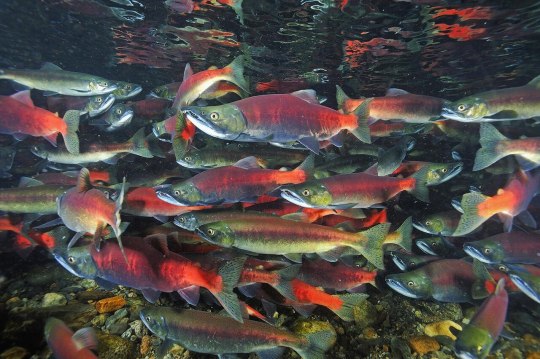
(kokanee salmon)
The Formosan landlocked salmon, also called the Cherry salmon, is found in Taiwan. Living in the Lishan mountain range, these fish survive in cold water at extremely high altitudes, with an upper temperature limit of 60 degrees. These fish are thought to have become landlocked by the warming of the Dajia River during the last ice age. They live along the many small creeks and backwater streams, with an extremely endangered population with only around 4,000 living at any given time. Cherry salmon are exceptionally small, reaching only 30cm (around a foot) with most around only 6 inches in their adult life. Subsisting off of bugs and small terrestrial life that gets close to the water. These fish survive only around 4 to 5 years before breeding in higher colder waters, and passing away for their fry to replace them.
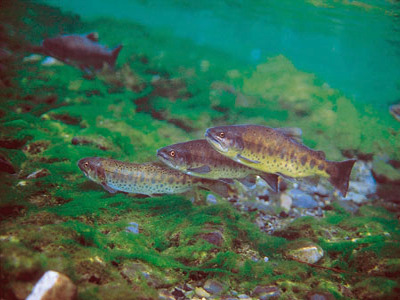
(Formosan landlocked salmon)
Those are the landlocked Salmon everybody! Have a wonderful day
#fish#fish of the day#fishblr#fishposting#aquatic biology#marine biology#freshwater#freshwater fish#animal facts#animal#animals#fishes#informative#education#aquatic#aquatic life#nature#river#ocean#salmon#landlocked#Formosan landlocked salmon#kokanee salmon#Atlantic salmon#sockeye salmon
85 notes
·
View notes
Text
The radioisotope experiments on that lake near me are fascinating in so many ways but mostly in the Jurassic park/chaos theory aspect.
The lake’s outlet was dredged, beavers removed, and fish species (native and otherwise) poisoned in an attempt to control nature and minimize manipulated variables. Then the steelhead they put in decided to be rainbow trout and wouldn’t go to sea. The lake was poisoned again to hopefully start over with a clean slate.
After that, they put in steelhead x rainbow trout hybrids (they’re the same species!! Literally the same!!) and numerous were eaten by steelheads that had managed to survive. And ofc these “hybrids” didn’t want to go to sea either (“the rainbow trout genes were dominant”) so they poison the lake again and put in sockeye who ate so much and grew so quickly it threw off their life cycle and also didn’t want to go to sea!
If you go there now the beavers are back and the creek has returned to a natural state. Nature Life uh finds a way.
#salmon#fish#steelhead and rainbow trout are the exact same species#one goes to sea and one doesn’t#sockeye also have a non anadromus version called Kokanee but I believe they’re considered a different species technically)#*i assume the wild fish are back too but I don’t fish there#the state has even quit stocking it for anglers as far as I can tell#C&R only#they also put in a fish barrier to stop wild fish from coming up stream?#‘the power of atoms won’t be measured in explosive power but in pounds of salmon’ <- slightly paraphrased but that’s what the goal was#I wonder if they killed the sockeye or if they were left after the excitement was done#could they have eventually gone to sea and created an introduced sockeye run on this creek? (a coho/chum/chinook creek)
41 notes
·
View notes
Text
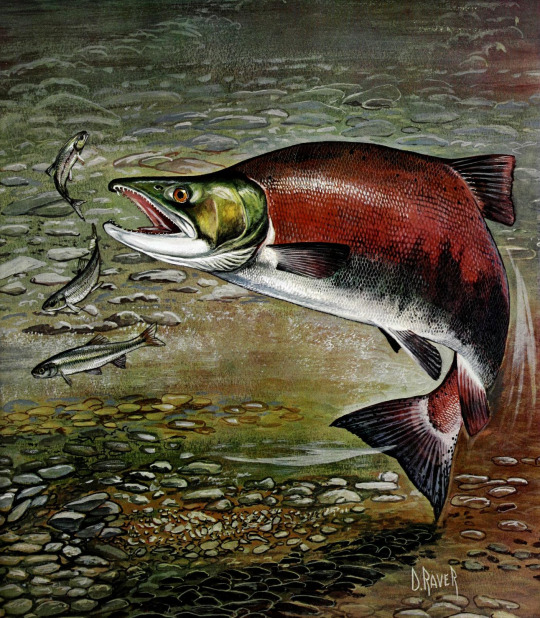
Wildlife in North Carolina. November 1965. Illustration by Duane Raver Jr.
Internet Archive
417 notes
·
View notes
Text
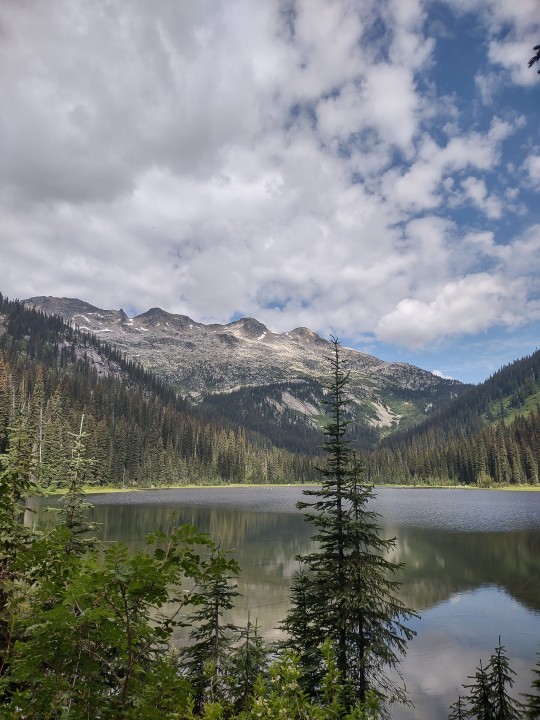
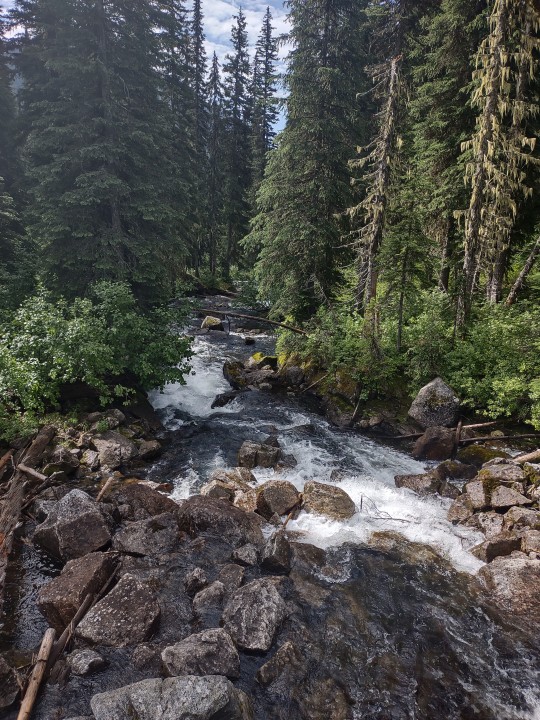

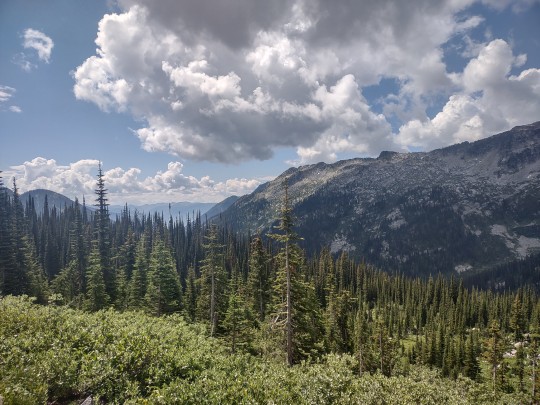
7.13.2023.
Kokanee Lake Trail was so gorgeous 😍 Everything is so green and lush. Waterfalls everywhere! We passed quite a few hikers on the trail and everyone was really nice. It's a little over 6 miles for the entire hike, and a little under 2,000 ft elevation gain. We were going to adventure to the Kokanee Glacier Cabin but thunderstorms were rollin' in so we headed back after reaching the lake. I wish I could have the entire summer off to just explore here.
85 notes
·
View notes
Text
I got miller high life🤠
2 notes
·
View notes
Text
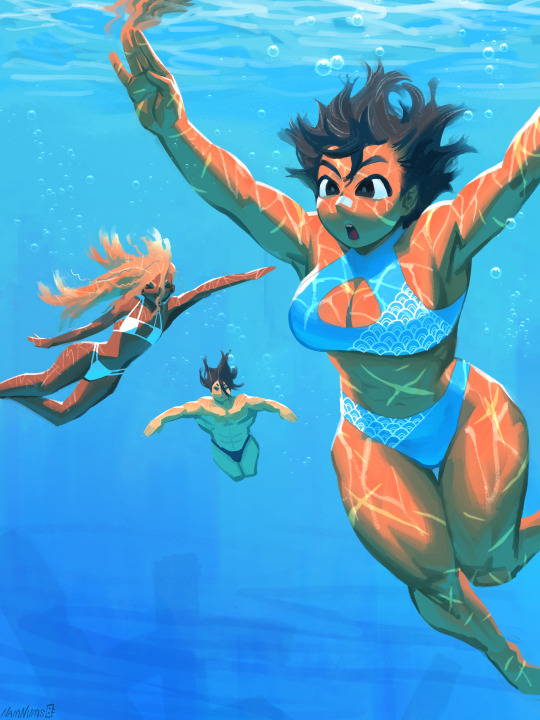
Finally painted my ocs again Timelapse
#art#digital illustration#digital painting#digital art#my art#illustratuon#painting#ocs#kokanee#gauge#wai#swimming#ocean#underwater
156 notes
·
View notes
Text

Kokanee Creek
2 notes
·
View notes
Text

"Shiny Kokanee"
Infinite Painter.
I was thinking, "what if there was a horny salmon who turned rainbow-coloured rather than just red? wouldn't that be cool?".
CC-BY-SA 4.0
1 note
·
View note
Text
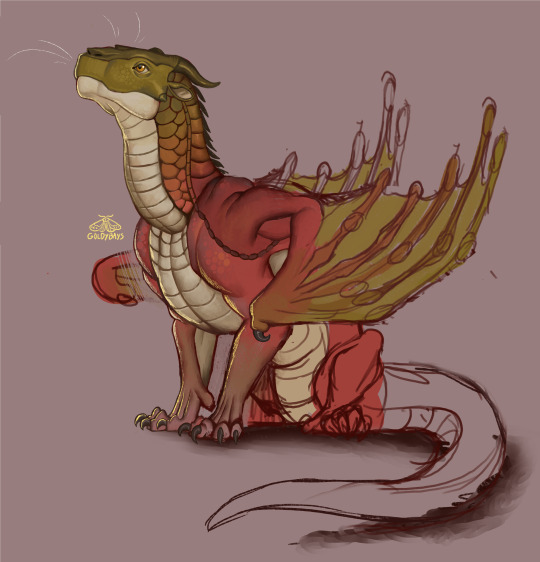
kokanee, or koko the mudwing
1K notes
·
View notes
Text
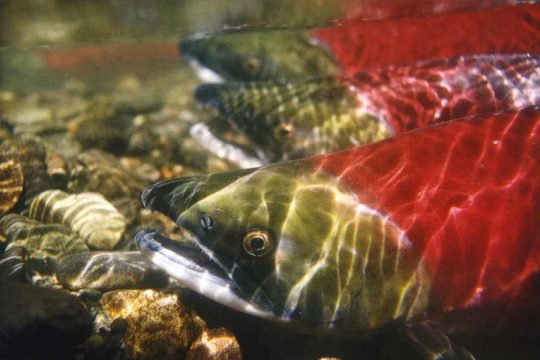


Settle In with the Sockeye Salmon
The sockeye salmon (Oncorhynchus nerka), also known as the red salmon, or the blueback salmon, is one of thirteen species of salmon endemic to the north Pacific Ocean. In their juvenile years they live in the open sea, but as fresh hatchlings and adults they can be found in freshwater rivers and streams. However, the subspecies known as the kokanee salmon are trapped in landlocked lakes and do not migrate as other sockeye salmon do. When migrating, the species can venture well inland to western North America and portions of eastern Asia, including Japan, Russia, and parts of Siberia.
Like most salmon, the sockeye is most famous for its lifecycle. It is an anadromous species, meaning that individuals migrate based on their life state. Newly hatched fry emerge from nests laid in the beds of freshwater systems, and spend their first 1-3 years before moving downstream to the ocean. There, they spend another 4-5 years in schools of up to several hundred, before they reach sexual maturity.
Beginning in July, mature adults begin the great migration back to the area in which they spawned. Once they reach their breeding grounds, males form into strict heirarchical groups and begin to court the available females. Meanwhile, each female digs a shallow nest in the riverbed and lays her eggs. Her chosen male partner-- or several-- lays a cloud of sperm over the eggs. A male may fertilize several nests before he dies; the female perishes soon after. The eggs, laid in clutches of up to 200, take approximately 40 days to hatch, at which point the cycle begins again.
As juveniles living in the ocean, red salmon are somewhat unremarkable. They have long, torpedo-shaped bodies that are generally silvery blue in color, sometimes with dark speckling. Individuals retain this coloring until well into their journy as adults, where males and females begin to significantly diverge. At their peak, adults may be anywhere from 60 to 84 cm (2 ft 0 in – 2 ft 9 in) in length and weigh from 2.3 to 7 kg (5–15 lb), with males being somewhat larger than females. Both males and females also change color; the head turns green, while the body turns bright red, although the color change is more striking in males. Finally, the shape of the male changes drastically, with the mouth becoming more hooked and the body growing a large hump.
Unlike other salmon, both adults and juvenile O. nerka feed throughout their lives. Fry and ocean-bound juveniles feed mainly on copepods and other zooplankton, while migrating adults also consume larger insects and invertebrates. Young blueback salmon are vulnerable to predation from larger fish such as lake trout, squawfish, and mountain whitefish, as well as larger invertebrates and frogs. Individuals living in the ocean are less predated upon, although they can still be caught by larger animals such as seals, sea lions, and sharks. Terminal-stage adults are large, easy targets and are consumed by a range of species; most namely bears and large birds such as gulls and eagles.
Conservation status: The IUCN considers the sockeye salmon to be of Least Concern. However, the species is listed on the United States Endangered Species Act. Populations have declined significantly throughout its range, largly due to overfishing, habitat degredation and the destruction of their breeding grounds.
Photos
NOAA Fisheries
Sergei Gorshkov
Roger Phillips
#sockeye salmon#Salmoniformes#Salmonidae#pacific salmon#salmon#salmonids#fish#freshwater fauna#freshwater fish#rivers#river fish#marine fauna#marine fish#open ocean#open ocean fish#Pacific ocean#north america#western north america#asia#east asia#north asia#animal facts#biology#zoology#ecology
70 notes
·
View notes